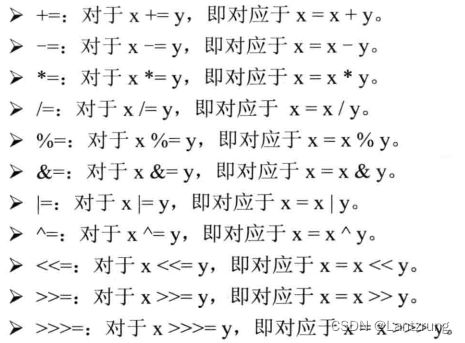08※、运算符的使用
运算符的使用
--算术运算符 + - * / %
+的作用:实现加法运算,实现字符串的拼接
/**
* @author Lantzrung
* @date 2022年7月17日
* @Description
*/
String res = 5+6+"abc";//Output: 11abc
String res1 = "abc"+5+6;//Output:abc56 cause:前面是String类型的字符串拼接,所以后面也是字符拼
//接,而不是加法运算了
String res2 = "abc"+5+6+7+8+9;//Output:abc56789;
int res3 = 8/0;//java.lang.ArithmeticException: / by zero 0不能作为被除数
int res4 = 8/0.2;//compile error:不兼容的类型,float类型无法转换成int类型
double res5 = 8%3.1;// 1.8--->1.7999999999998--扩展后的赋值运算符
注意:扩展后的赋值运算符中包含强制类型转换操作
item += 3;不完全等于item = item +3;
而是等于item = (item的类型)(item +3);
/**
* @author Lantzrung
* @date 2022年7月17日
* @Description
*/
int x = 3;
int y = 5;
x = x + y;//Output:8;
x += y;//Output:8; int x = (int) y;
这里插入一个经典笔试题:
short i = 0;//为什么 i += 5 可以? 而i = i + 5出现错误;
i += 5;//cause:此运算赋值符包含强转类型,i = (short)(i+5);
i = i + 5;//compile error : 不兼容的类型: 从int类型转换short类型成可能会损失
System.out.println(i);
--位运算符
/**
* @author Lantzrung
* @date 2022年7月17日
* @Description
*/
//0000 0111 7
//0000 0101 7
//0000 0101 5
int res1 = 7&5;//按位与 全真(1)则为真(1) 有假(0)则为假(0)
//0000 0101 5
//0000 0001 1
//0000 0001 1
int res2 = 5&1;//Output:1
//0000 0111 7
//0000 0101 5
//0000 0101 7
int res3 = 7&5;//按位或: 有真(1)则为真(1) 全假(0)则为假(0)
//0000 0101 5
//0000 0010 2
//0000 0111 7
int res4 = 5|2;//7
//0000 0101 5
※//1111 1010 -1-4-1=-6
int res5 = ~5; //Output:-6 取反,因为符号[将所有进行取反,包括符号位]
//0000 1010 10
※//1111 0101 -1-8-2=-11
int res6 = ~11; //Output:-11
//0000 0111 7
//0000 0101 5
//0000 0010 2
int res7 = 7^5;//2 按位异或 不同则为真(1) 相同则为假(0)
//0000 0101 5
//0000 1110 14
//0000 1011 11
int res8 = 14^5;//11
//0000 0101 5
//0000 1010 10
int res9 = 5<<1;//10 左移一位 低位补0
//1111 0101 -2-8=-10
//1110 1010 -16-4-1=-20
int res10 = -10<<1;//-20
//0000 0101 5
//0000 0010 2
int res10 = 5>>1;// 右移一位 高位补符号位
//1111 1010 -5
※//1111 1101 -1-2=-3//因为符号位是负数 故要补位-1
int res11 = -5>>1;//-3 右移一位
//1111 1111 1111 1111 1111 1111 1111 1011 (8*4=32bit)
//0111 1111 1111 1111 1111 1111 1111 1101
int res12 = -5 >>> 1;//2
//1111 1111就是-1所以要-1--左移 双目运算符 案例 : 8向左移动一位,低位补0
--有符号右移>> 高位补符号位
--无符号右移>>> 高位补0
笔试题:如何最快的实现2*8? 2<<3 唔姆这里详细过程我以后另外一下解释qwq
--运算符的优先级(由高到低)
/**
* @author Lantzrung
* @date 2022年7月17日
* @Description
*/
分隔符 . [] () {} , ;
单目运算符 ++ -- ~ !
强制类型转换运算符 (type)
乘法/除法/求余 * / %
加法/减法 + -
移位运算符 << >> >>>
关系运算符 < <= >= > instanceof
等价运算符 == !=
按位与 &
按位或 ^
条件与 &&
条件或 ||
三目运算符 ?:
赋值 = += -= *= /= |= ^= %= <<= >>= >>>= --比较运算符(短路和非短路的概念)
> < >=
--逻辑运算符
--短路与 如果前面的表达式为假,则后面不需要在判断,直接短路
--短路或 前面为真,则直接短路,不执行后面的逻辑判断
/**
* @author Lantzrung
* @date 2022年7月17日
* @Description
*/
//1、逻辑运算符
//与:全真(对)则为真,有假(错)则为假
//必须都是true(1)真才返回true 否则返回false
if((3>2)&(4>2)) {}//真真 对对 运行通过
if((3>2)&(1>2)) {}//真假 对错
if((1>2)&(0>2)) {}//假假 错错
if((1>2)&(3>2)) {}//假真 错对
//或:有真则为真,全假则为全假
//只要有一个是true(1)真就返回true 否则返回false
if((3>2)|(4>2)) {
}//真真 对对
if((3>2)|(1>2)) {}//真假 对错 运行通过
if((1>2)|(0>2)) {}//假假 错错 运行通过
if((1>2)|(3>2)) {}//假真 错对 运行通过
//短路和非短路的区别 非短路所有条件都要进行判断
//短路与: 必须都为true时执行并返回true 否则返回false
//两个逻辑判断必须true时才会执行通过 否则都不执行
if((3>2)&&(4>2)) {}//真真 对对 运行通过
if((3>2)&&(1>2)) {}//真假 对错
if((1>2)&&(0>2)) {}//假假 错错
if((1>2)&&(3>2)) {}//假真 错对
//短路或:有一个true时就可以返回true并执行不继续执行下一个方法条件,否则返回false
//当都是false或者有一个false时 不会执行当前逻辑判断
if((3>2)||(4>2)) {}//真真 对对 运行通过
if((3>2)||(1>2)) {}//真假 对错 运行通过 前者执行 后者不执行
if((1>2)||(0>2)) {}//假假 错错
if((1>2)||(3>2)) {}//假真 错对 运行通过 前者不执行 后者执行--三目运算符(三个操作元素,相当于判断语句)
(逻辑表达式)?数值1:数值2
如果表达式为真 则赋值数值1,为假则赋值数值2
/**
* @author Lantzrung
* @date 2022年7月19日
* @Description
*/
public class Demo {
public static void main(String[] args) {
int score = 86;
String ispass = (score>=60)?"及格":"不及格";
System.out.println(score+"为"+ispass);
//90~100A 75~90B >=60 C <60D
String level = (score>=90)?"A":(score>=75)?"B":(score>=60)?"C":"D";
System.out.println(score+"为"+level);
}
}--自增自减操作
如果自增或自减符号和其他运算符一起操作时,会有顺序的先后:
++在变量的后面,所以先进行算术运算再进行自增操作
++在变量的前面,所以先进行进行自增操作再算术运算
/**
* @author Lantzrung
* @date 2022年7月19日
* @Description
*/
public class Test02 {
public static void main(String[] args) {
int i = 3; // i++ --> i+1 --> i先赋值再自增+1
// int a = i+++4;//其实这里就是i++ + 4
int a = i++ + 4;// 思考,这里输出的是8 还是 7呢?
System.out.println("i:" + i);// 4
System.out.println("a:" + a);// 7 答案是7,为什么不是8上面i都输出是4了,这是为什么
// 呢?
// 因为i++是先赋值后自增加1的,也就是说i是先赋值3的值去和a是4的值去运算先,再把结果等
// 于7的值赋值给a
// 然后a输出是7的值,最后i才进行自增加1
// 这里记得变量i要换一个继续定义等于3 因为上次自增后结果不等于3了
int i1 = 3;
int a1 = ++i1 + 4;//这次是8 还是 7呢?qwq
System.out.println("i1:"+i1);//4
System.out.println("a1:"+a1);//8 答案是8 详细我也不解释了
// 简要的概括就是:
// ++在变量后面涉及到其他的运算时,则先执行其他的运算,然后再自增
// ++在变量前面涉及到其他的运算时,则先自增,然后再执行其他的运算
}
}
/**
* @author Lantzrung
* @date 2022年7月19日
* @Description
*/
public class Demo01 {
public static void main(String[] args) {
int i = 5;
int b = 6;
if ((i++ == 5) && (++b == 6)) {
// 分析:因为有小括号,所以优先级是先算小括号里面的,然后再执行短语与的,
// 前者执行条件中先赋值,故此5==5成立,最后再自增1;
// 后者执行条件中先自增+1,故此7==6不成立,false又因是短路与,故此执行体中期改
// i=7;不执行
// 但最后b还是等于7 a是等于6
i = 7;
}
System.out.println(i);// 6
System.out.println(b);// 7
int i1 = 5;
int b1 = 6;
if ((i1++ == 5) || (++b1 == 6)) {
// 分析:前者执行条件中成立 最后i1自增等于6(但还不是最终结果);
// 因为这个是短语或,因为前者已经是true了,所以后者不执行直接输出b1是等于6,
// 最后执行方法体中的i1=7,直接把之前i1=6覆盖掉了
i1 = 7;
}
System.out.println(i1);// 7
System.out.println(b1);// 6
int i2 = 5;
int b2 = 6;
if ((i2++ == 5) & (6 / (b2++ -6)) > 0) {
i2 = 7;
}
System.out.println(i2);//编译错误因为被除数不能为0,b2:6-6是等于0的所以报
//错:Exception in thread "main" java.lang.ArithmeticException: / by zero
//System.out.println(b2);
}
}


